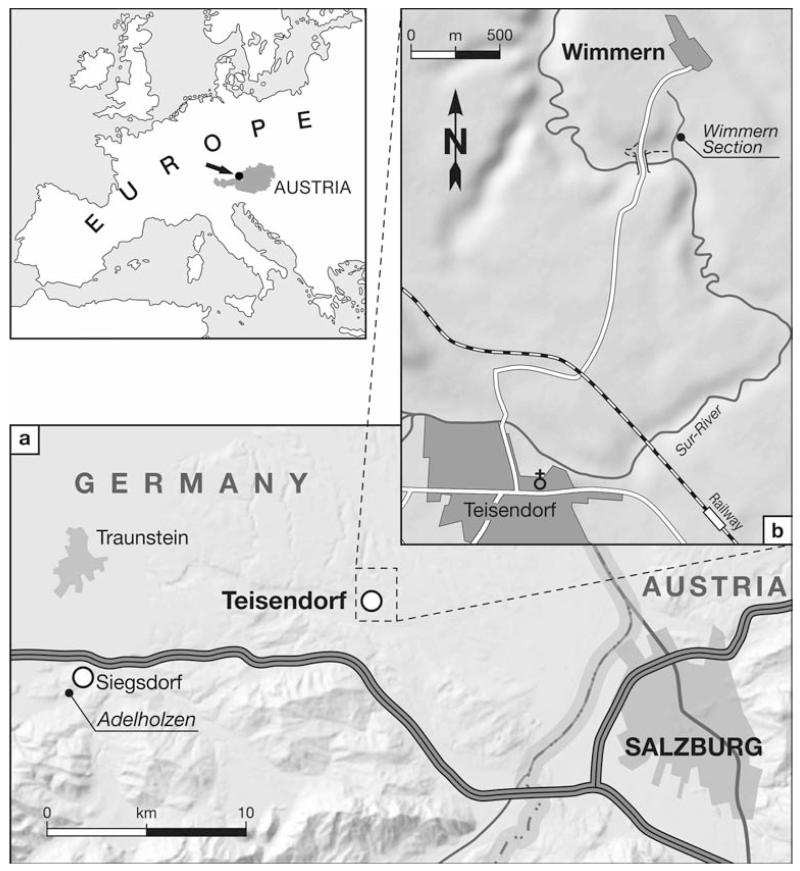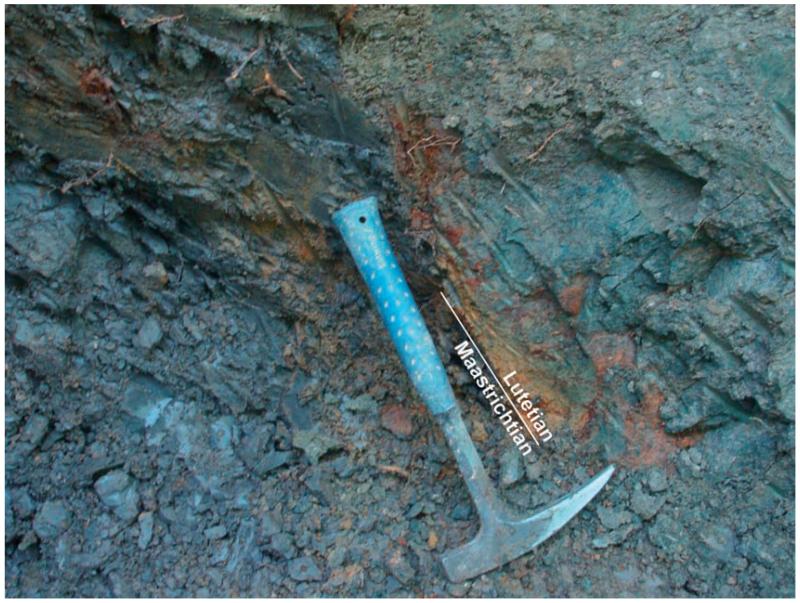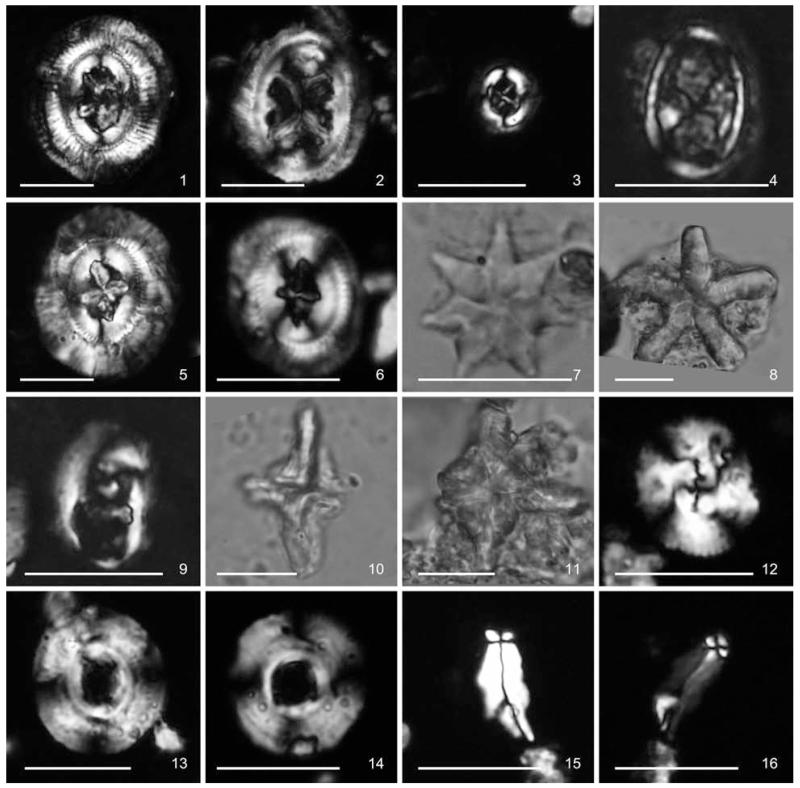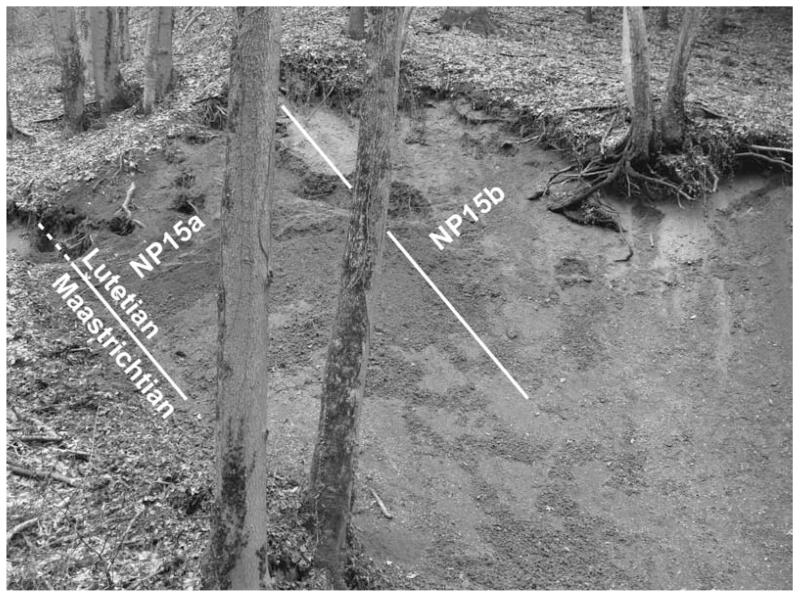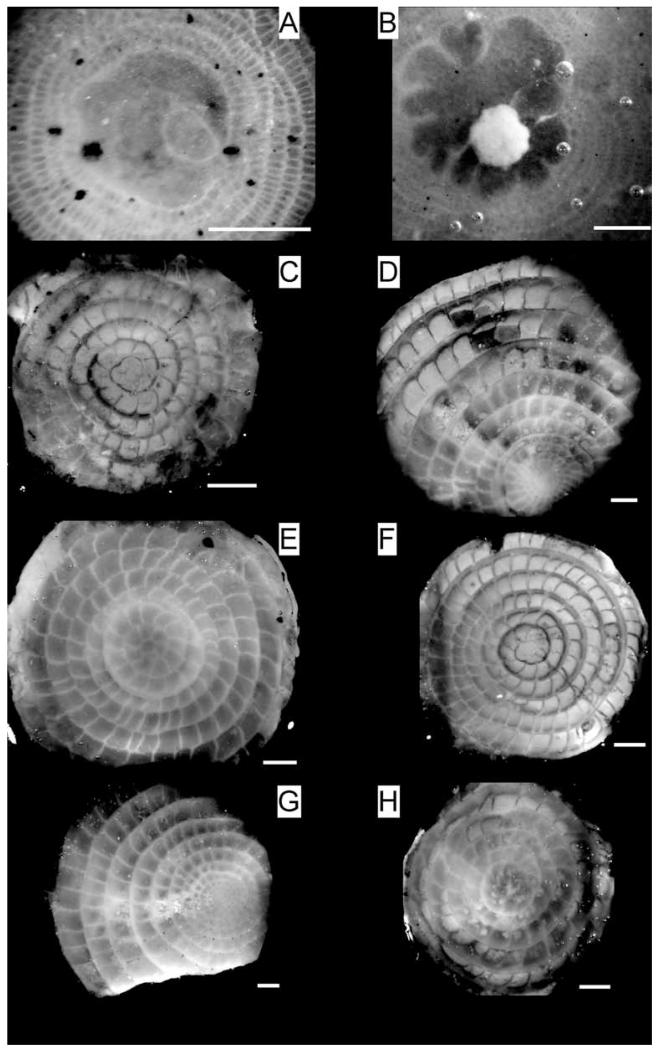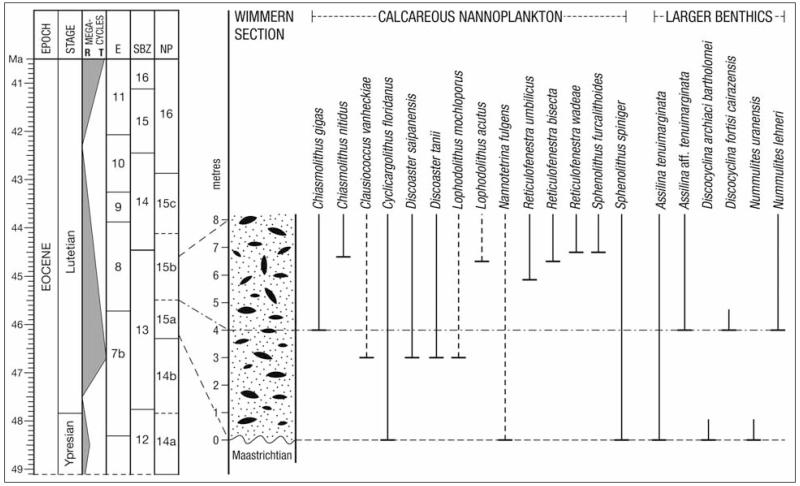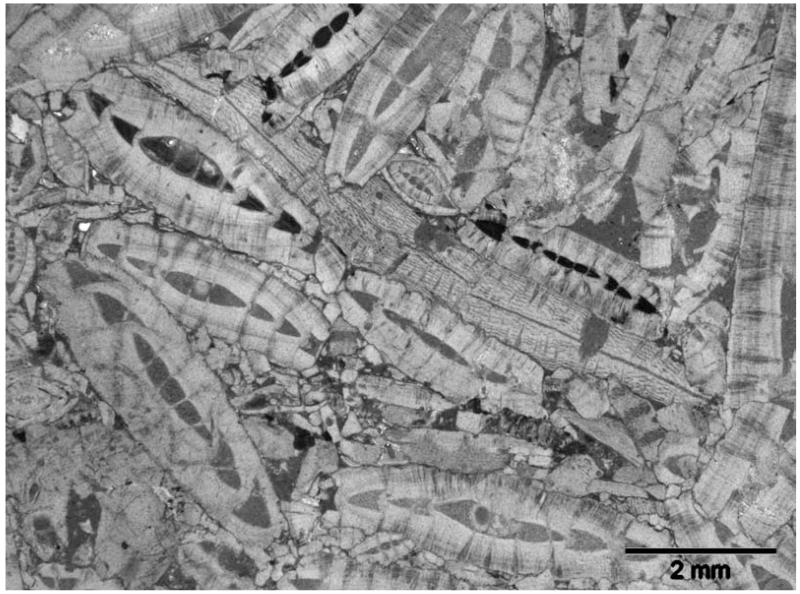Abstract
The middle Eocene Adelholzen beds were deposited on the northern part of the Tethyan shelf of the European Plate. In the Eastern Alps, the Wimmern section near Teisendorf (Germany) is the only known outcrop exposing the basal unconformity of this sequence. The outcrop comprises an 8 m thick condensed transgressive shallow marine succession characterized by glauconite-rich weakly consolidated greensand and mudstone containing abundant larger benthic foraminifera. It spans the lower part of calcareous nannoplankton Zone NP15 (Sub-Zones NP15a and lower part of NP15b), planktonic foraminifera Sub-Zone E7b and Zone E8 partim and the upper part of shallow benthic Zone SBZ13. The landward migration of the paleo-shoreline was not an effect of flexural downbending of the European Plate but can be correlated to the major unconformity at the base of eustatic supercycle TA3. The onset of this sea-level rise was in the latest part of Biochron NP14b and almost coincided with the NP14b/NP15a-boundary.
Keywords: Northwestern Tethys, Lutetian, calcareous nannoplankton, foraminifera, sea-level changes
1. Introduction
The Global Boundary Stratotype Section and Point (GSSP) for the Ypresian/Lutetian-boundary has recently been defined at the bathyal Gorrondatxe section near Bilbao in Spain (Molina et al. 2011). At other sections, the primary correlation marker for this stratigraphic level is the lowest occurrence (LO) of the calcareous nannoplankton species Blackites inflatus, which is indicative for the base of calcareous nannoplankton Subzone NP14b. At the original Lutetian stratotype (St. Leu d’Esserent in the Paris Basin) the transgressive base of the Lutetian is within this Subzone, however, there is strong suspicion that it is situated in the upper part of Subzone NP14b (Aubry 1991).
In the Swiss and Bavarian Alps, transgressive deposits of middle Eocene age are long-known from the Helvetic nappe system, which comprises parts of the Tethyan shelf of the European Plate. With an erosional unconformity, Lutetian deposits rest on Campanian to Maastrichtian rocks in the northern part of the shelf. Hagn (1954) attributed this transgression to a global eustatic sea-level rise at the onset of the Lutetian. In Bavaria, this transgressive sequence is called Adelholzen beds (Schafhäutl 1846) and shows a three-fold lithological subdivision into basal greensand, overlying marlstone and limestone extremely abundant in larger foraminifera, and greenish marlstone at the top (Reis 1896). Due to the lack of a valid lithostratigraphic definition, the Adelholzen beds are still an informal lithostratigraphic unit.
From the basal part of the Adelholzen beds at the type locality Nummulites lehneri and N. aff. gallensis were reported by Pavlovec (in Hagn 1973). Both species are indicative for Shallow Benthic Zone SBZ13 in the zonation scheme of Serra-Kiel et al. (1998). The range of this benthic zone comprises Subzones NP14b, NP15a and a major part of NP15b (Serra-Kiel et al. 1998). This original type locality of the Adelholzen beds in the Höllgraben near Siegsdorf (Fig. 1a) is not accessible anymore, but at the base of an adjacent neostratotype section (behind the mineral water bottling plant of “Adelholzener Alpenquelle”) SBZ13 was found with a thickness of less than 2 m (Gebhardt et al. 2011). However, there the contact to the underlying Maastrichtian is formed by a tectonic fault and the sedimentary base of the transgressive sequence is not exposed.
Fig. 1.
Location of the Wimmern section in eastern Bavaria (Germany).
For this paper, we studied the Bavarian Wimmern section (Fig. 1b), which is the only known exposure of the transgressional base of the Adelholzen beds in the Bavarian and Austrian Alps. The aims of this paper are (1) to give a precise chronostratigraphic age for the onset of the middle Eocene transgression on the northern Helvetic shelf (northwestern Tethyan realm) by an integrated multistratigraphic approach (calcareous nannoplankton, planktonic foraminifera, larger benthic foraminifera), and (2) to evaluate the global or regional significance of this sea-level rise.
2. Geological Setting
The 8 m thick Wimmern section (lat. 47° 52′ 08″ N; long. 012° 49′ 56″ E) is located in eastern Bavaria (Germany), about 15 km northwest of Salzburg (Fig. 1b). A major unconformity, separating grey Maastrichtian marlstone (Gerhardsreit Formation) below from glauconitic greensand (Adelholzen beds) above, is exposed at the basal part of the section (Fig. 2). A hiatus of about 22 million years (from ca. 70 to 48 Ma) is associated with this surface. Both lithostratigraphic units are part of the Helvetic nappe system, which consists of Triassic to upper Eocene sedimentary rocks from the Tethyan shelf of the European continental plate.
Fig. 2.
Sedimentary contact between dark grey Maastrichtian marlstone and Lutetian greensand at the Wimmern section.
Between Lake Thun in Switzerland and Lake Gmunden in Upper Austria, over a distance of ca. 500 km, the Paleocene and Eocene sedimentary record of the Helvetic shelf is amazingly uniform. This continuous facies development signalizes a low diversity of topographic features at the sea-floor. The sedimentary record is punctuated by a number of stratigraphic gaps, which become more pronounced in direction to the coast of the European continent in the north (Egger 2011). This indicates that the Helvetic sedimentary realm was a seaward-dipping platform with a smooth surface. The width of this ramp is unknown because the original configuration of sedimentation areas was destroyed by thrusting and faulting after the continental collision between the European and Adriatic Plates in the late Priabonian (Handy et al. 2010).
3. Material and methods
In total, 14 samples distributed over the entire section were studied for calcareous nannoplankton, planktonic, smaller benthic, and larger benthic foraminifera. The sample numbers represent the centimeter distance of the sample above (+) the transgressional surface at the base of the Lutetian. The washing residues of the samples are dominated by glauconitic grains together with biogenic detrital material and larger foraminifera. Only in the finest fraction (125 to 63 μm) detrital quartz is present. Smaller benthic foraminifera are commonly recrystallized and corroded, planktonic foraminifera are rare, sometimes preserved as glauconitic casts. Very few ostracods are present. The tropical to subtropical planktonic foraminiferal standard zonation of Wade et al. (2011) has been followed for the zonal assignment of the assemblages.
For calcareous nannofossil studies, smear slides were studied with the light microscope under parallel and crossed polarisation filters at a magnification of 1000×. The majority of the specimens are slightly etched but all taxa were easily identified. Generally, species richness is low in the studied samples. The reader is referred to Perch-Nielsen (1985) and Bown (2005) for nannoplankton taxonomy. For the zonal assignment of the samples, the calcareous nannoplankton zonation (NP zones) of Martini (1971) was used, as this is correlated to the chronostratigraphical and geochronological framework of Vandenberghe et al. (2012).
To study the larger benthic foraminifera assemblages, several specimens have been selected from the fraction 250-500 μm and > 500 μm. They were polished to obtain equatorial sections and then glued on thin section slides. The specimens have not been sliced to prepare thin sections in order to preserve the external shell morphology, which can be very important for taxonomic analyses. For taxonomic identification of the nummulitids the monograph by Schaub (1981) was used. Biostratigraphy was done on the base of the zonation scheme of Serra-Kiel et al. (1998), which was refined by Rodriguez-Pinto et al. (2012). For orthophragminids, the monograph published by Less (1987) was used for basic biometric analyses. For the stratigraphic distribution and subspecies identification, the papers by Zakrevskaya et al. (2011) and Özcan et al. (2007) were followed.
4. Results
4.1 Calcareous nannoplankton
Calcareous nannoplankton assemblages show moderate preservation throughout the section. Reworking of Upper Cretaceous and Paleocene taxa is low (1–2%). Very rare specimens of Discoaster kuepperi (e. g. sample +300 cm), Discoaster lodoensis, and Tribrachiatus orthostylus (e. g. sample +650 cm) are reworked Ypresian species and so it cannot be ruled out that part of the very common Reticulofenestra dictyoda and Coccolithus pelagicus specimens originate also from the lower Eocene. Quantitatively, the assemblages consist essentially of Reticulofenestra dictyoda, R. minuta, and Coccolithus pelagicus, which together form about 80% of the assemblages. Other common species occurring in all samples are Chiasmolithus solitus, Coronocyclus bramlettei, Cyclicargolithus floridanus, Discoaster barbadiensis, Sphenolithus spiniger and Zygrhablithus bijugatus. Images of stratigraphically important species are given in Fig. 3.
Fig. 3.
Stratigraphically important calcareous nannoplankton species of the Wimmern section (1. Chiasmolithus gigas (+650 cm); 2. Ch. grandis (+600 cm); 3. Ch. nitidus (+670 cm); 4. Clausiococcus vanheckae (+300 cm); 5. Coccolithus mutatus(+650 cm); 6.Coccolithus staurion(+600 cm); 7.Discoaster saipanensis(+300 cm); 8.D. tanii(+650 cm); 9.Lophodolithus acutus (+800 cm); 10. Nannotetrina fulgens (+2 cm); 11. N. fulgens (+20 cm); 12. Reticulofenestra bisecta (+650 cm); 13. R. umbilicus (+670 cm); 14. R. wadeae (+670 cm); 15, 16. Sphenolithus furcalithoides (+670 cm). Scale bar for all images is 10 m.
In the lowest sample (+2 cm above the transgressional surface) Nannotetrina fulgens (Fig. 3/9) occurs. The stratigraphic range of this species defines the Nannotetrina fulgens Zone of the lower Lutetian. The N. fulgens Zone represents Zone NP15 in the zonation scheme of Martini (1971) and Zone CP13 in the zonation scheme of Okada and Bukry (1980). The latter authors suggested a three-fold subdivision of the Nannotetrina fulgens Zone using the range of Chiasmolithus gigas (Fig. 3/1), which is restricted to the middle part (CP13b) of the Nannotetrina fulgens Zone. Aubry (1991) has defined Subzone NP15a as the interval between the LO of N. fulgens and the LO of Ch. gigas, Subzone NP15b as the total range of Ch. gigas, and Subzone NP15c as the interval between the HO (highest occurrence) of Ch. gigas and the HO of Blackites gladius. The latter species was not found at Wimmern.
In the Wimmern section Ch. gigas has its LO +400 cm above the transgressive surface and occurs from there to the top of the section. Using the criteria of Aubry (1991), the lower part (0–400 cm) of the Lutetian at the Wimmern section can be assigned to Subzone NP15a, the upper part to Subzone NP15b (Fig. 4).
Fig. 4.
Biostratigraphic subdivision of the Wimmern section based on calcareous nannoplankton stratigraphy.
The ranges of stratigraphically important calcareous nannoplankton species are given in Fig. 6. The following important biostratigraphic events were recognized at the Wimmern section:
-
i)
In sample +300 cm Discoaster saipanensis (Fig. 3/6) and Discoaster tanii (Fig. 3/7) have their lower occurrences. Martini (1971) reported the LO of D. saipanensis in the upper part of Zone NP16. The LO of D. tanii was placed within Zone NP17 (Perch-Nielsen 1985). The latter species is a typical member of upper Eocene to lower Oligocene tropical assemblages (Bukry 1973). In the north-western Tethys, both species were previously found within Subzone NP15b (Rögl and Egger 2010). The more extended record at Wimmern heralds the LO of D. saipanensis and D. tanii in the upper part of Subzone NP15a.
-
ii)
In sample +400 cm the LO of Chiasmolithus gigas (Fig. 3/1) marks the base of Subzone NP15b. It was found up to the top of the section and co-occurs in some samples with Coccolithus mutatus (Fig. 3/5) and Coccolithus staurion (Fig. 3/6), which both occur sporadically.
-
iii)
In sample +600 cm Reticulofenestra umbilicus (Fig. 3/12) has its LO. The specimens have diameters of more than 14 μm, a size proposed to be diagnostic for this species (Backman and Hermelin 1986). Martini (1971) reported the LO of R. umbilicus in the lower part of Zone NP15 whereas Bukry (1973) created a R. umbilicus Zone above a Nannotetrina quadrata Zone, which corresponds to Zone NP15. Perch-Nielsen (1985) followed this and used the LO of R. umbilicus as a proxy for the base of Zone NP16. Vandenberghe et al. (2012) place the LO of R. umbilicus (> 14 μm) in the middle of NP16. In contrast, in the North Sea basin abundant occurrences of R. umbilicus are reported from Zone NP15 (Varol 1998, Thomsen et al. 2012). This is consistent with the record at Wimmern, where first rare specimens of R. umbilicus (> 14 μm) occur within Subzone NP15b.
-
iv)
In sample +650 cm Reticulofenestra bisecta (Fig. 3/11) has its LO within Subzone NP15b. Perch-Nielsen (1985) considered the LO of this species to be within NP17.
-
v)
In sample +670 cm Sphenolithus furcalithoides (Fig. 3/14 and 15), Chiasmolithus nitidus (Fig. 4/3), and Reticulofenestra wadeae (Fig. 3/13) have their LO within Subzone NP15b. In the excellently preserved material from Tanzania, S. furcalithoides and R. wadeae are restricted to Subzones NP15b and NP15c (Bown 2005). At the Italian Contessa section, S. furcalithoides has its LO in the lower part of Subzone NP15b (Jovane et al. 2010). Ch. nitidus has a range from NP15b to the lower part of NP16 (Perch-Nielsen 1985).
Probably due to preservational conditions other stratigraphically important species occur only exceedingly rare at Wimmern: Clausiococcus vanheckiae (Fig. 3/4) was described in NP15 and NP16 from the South Atlantic (Perch-Nielsen 1985). In Tanzania, the LO of this species is in the upper part of Subzone NP15a (Bown 2005), which is in line with its LO in sample +300 cm at Wimmern. Lophodolithus mochloporus (LO +300 cm) has a range from Zone NP13 to Subzone NP15b and L. acutus (LO +650 cm; Fig. 3/8) is restricted to Zone NP15 (Perch-Nielsen 1985).
Fig. 6.
A: Discocyclina archiaci bartholomei (+100 cm); B: Discocyclina fortisi cairazensis (+400 cm); C: Assilina cuvillieri (+100 cm); D: Assilina tenuimarginata (B-form), (+400 cm); E: Assilina tenuimarginata (+100 cm); F: Assilina tenuimarginata (+700 cm); G: Assilina aff. tenuimarginata (B-form), (+400 cm); H: Nummulites lehneri (+400 cm). Scale bars: A, B = 0,5 mm; C–H = 1 mm.
4.2 Planktonic and smaller benthic foraminifera
Planktonic foraminiferal assemblages at the Wimmern section are characterized by common acarininids. Probably as an effect of sorting, the acarininid specimens display small sizes between 100 and 200 μm. Most of the larger acarininid specimens are affected by corrosion and abrasion. Subbotinids are very rare and morozovellids almost missing. The stratigraphic ranges of some acarininid species indicate substantial reworking from the Ypresian planktonic foraminifera Zones E5 to E6 throughout the section (Table 1). Stratigraphic ranges of the species according to Olsson et al. (1999), Berggren and Pearson (2005), Pearson et al. (2006), and Wade et al. (2011).
Table 1.
Stratigraphic ranges of planktonic foraminifera at the Wimmern section. The lowest three samples can be assigned to Zone E7, all other samples to Zone E8. Stratigraphic ranges after Olsson et al. (1999), Berggren and Pearson (2005), Pearson et al. (2006), and Wade et al. (2011).
| WIMMERN near Teisendorf, Bavaria | Wim-Basis | Wim +50 cm | Wim +80 cm | Wim +100 cm | Wim +200 cm | Wim +300 cm | Wim +380 cm | Wim +400 cm | Wim +600 cm | Wim +630 cm | Wim +660 cm | Wim +680 cm | Wim +700 cm | Wim +730 cm | |
|---|---|---|---|---|---|---|---|---|---|---|---|---|---|---|---|
| Acarinina coalingensis (Cushman & Hanna) | X | X | X | cf. | P4–E7 | ||||||||||
| Acarinina esnaensis (LeRoy) | X | X | X | X | X | X | (P5–E5)? | ||||||||
| Acarinina esnehensis (Nakkady) | X | X | X | X | X | X | X | X | (P5–E6)? | ||||||
| Acarinina interposita Subbotina | cf. | X | X | X | X | X | X | E4–E6 | |||||||
| Igorina wartsteinensis (Gohrbandt) | X | X | X | X | cf. | X | |||||||||
| Igorina lodoensis (Mallory) | X | P5–E6 | |||||||||||||
| Planorotalites pseudoscitula (Glaessner) | X | X | X | cf. | X | X | P5–E7 | ||||||||
| Pseudohastigerina wilcoxensis (Cushman & Ponton) | X | X | X | X | X | X | X | X | X | X | X | X | E2–E10 | ||
| Jenkinsina triseriata (Terquem) | X | X | X | E7–E10 | |||||||||||
| Subbotina eocaena (Gümbel) | X | X | X | X | X | X | cf. | X | cf. | ||||||
| Subbotina linaperta (Finlay) | X | X | X | X | X | X | X | X | E5–E16 | ||||||
| Acarinina bullbrooki (Bolli) | X | X | X | X | X | X | X | X | X | X | X | X | X | E7–E11 | |
| Acarinina collactea (Finlay) | X | X | cf. | X | X | X | X | cf. | X | X | E7–E14 | ||||
| Acarinina cuneicamerata (Blow) | X | X | X | X | X | X | cf. | X | X | E6–E9 | |||||
| Acarinina pentacamerata (Subbotina) | X | X | X | X | X | cf. | X | X | cf. | X | E5–E7 | ||||
| Acarinina praetopilensis (Blow) | cf. | X | X | X | E7–E12 | ||||||||||
| Igorina broedermanni (Cushman & Bermudez) | X | X | X | X | X | X | X | X | X | cf. | E1–E9 | ||||
| Subbotina pseudosubsphaerica Pearson & Berggren | X | X | cf. | E7–E10 | |||||||||||
| Subbotina yeguaensis (Weinzierl & Applin) | cf. | cf. | cf. | E7–E16 | |||||||||||
| Pseudohastigerina micra (Cole) | X | X | X | X | X | X | E7–01 | ||||||||
| Globorotaloides quadrocameratus Olsson et al. | X | cf. | cf. | E2–E16 | |||||||||||
| Subbotina compacta (Subbotina) | X | X | |||||||||||||
| Morozovelloides bandyi (Fleisher) | X | X | X | X | E7–E10 | ||||||||||
| Acarinina angulosa (Bolli, 1957) | cf. | P5–E7 | |||||||||||||
| Acarinina primitiva (Finlay) | X | X | X | E6–E13 | |||||||||||
| Acarinina soldadoensis (Brönnimann) | X | cf. | cf. | cf. | P4–E7 | ||||||||||
| Acarinina pseudotopilensis Subbotina | X | X | X | P5–E7 | |||||||||||
| Planorotalites capdevilensis (Cushman & Ponton) | X | X | X | X | E7–E14 | ||||||||||
| Parasubbotina hagni (Gohrbandt) | cf. | ||||||||||||||
| Globoturborotalita bassriverensis Olsson & Hemleben | X | E1–E10 | |||||||||||||
| Subbotina senni (Beckmann) | cf. | X | X | X | X | E6–E13 | |||||||||
| Acarinina mcgowrani Wade & Pearson | X | X | X | X | X | X | E7–E13 | ||||||||
| Morozovelloides coronatus (Blow) | X | E8–E12 | |||||||||||||
| Globigerinatheka spp. | X | X | X | X | X | E8–E16 | |||||||||
| Guembelitrioides nuttalli (Hamilton) | X | E8–E10 | |||||||||||||
| Acarinina cf. topilensis (Cushman) | X | ||||||||||||||
|
|
|
|
|||||||||||||
| Umlagerung E5–E6 | E7 | E8 | |||||||||||||
The planktonic assemblages of the lowermost part of the section (Wim-Basis to Wim +80 cm) yield Acarinina bullbrooki, A. coalingensis, A. collactea, A. praetopilensis, Planorotalites pseudoscitula, and Pseudohastigerina micra. These species have stratigraphic ranges starting or ending within Zone E7 of Wade et al. (2011).
From sample +100 cm to the top of the section only very few specimens of stratigraphically important taxa appear. Most important are the occurrences of the genus Globigerinatheka and of Guembelitrioides nuttalli, both events indicating Zone E8. The species determination of Globigerinatheka is difficult due to the small size of most specimens and corrosion of the very rare larger specimens. Only one specimen of Morozovelloides coronatus was found in sample +100 cm, which has its LO in Zone E8 (Pearson et al. 2006).
The benthic assemblages of smaller foraminifera (Table 2) are dominated by Cibicidoides, Heterolepa and Hanzawaia. The composition of the assemblage is probably an effect of dissolution as miliolids are completely absent and larger lagenids as Lenticulina, Pyramidulina, and Laevidentalina are rare and corroded. Following species are common: Cibicidoides lopjanicus (Myatliuk), C. praelopjanicus (Myatliuk), C. pygmaeus (Hantken), C. tenellus (Reuss), Heterolepa cf. costata Franzenau, Hanzawaia producta (Terquem), Paralabamina tonica (Kraeva), Pijpersia coronaeformis (Pijpers), Bolivina cf. koessenensis Lindenberg, Asterigerina sp. In some samples small textulariids, living in sandy sediments (e. g., Textularia crookshanki Haque), appear in higher numbers. Interesting is the relatively common occurrence of the small Pijpersia coronaeformis (Pijpers) since the common occurrence of forms clinging to vegetation can be interpreted as indicator for a shallow water seagrass environment.
Table 2.
Smaller benthic foraminifera at the Wimmern section. The distribution and relative abundances of different species are given. Shallow water species are dominating the assemblages.
| WIMMERN near Teisendorf, Bavaria | Wim-Basis | Wim +200 cm | Wim +300 cm | Wim +730 cm |
|---|---|---|---|---|
| Ammodicus cretaceus (Reuss) | 1 | |||
| Karrerotextularia sp. | 1 | 2 | ||
| Semivulvulina pectinata (Reuss) | 3 | 5 | ||
| Vulvulina haeringensis (Guembel) | 1 | |||
| Textularia crookshanki Haque | 1 | 15 | 6 | |
| Milliammina sp. | 5 | |||
| Cornuspira involvens Reuss | 8 | |||
| Quinqueloculina sp. | 1 | 1 | ||
| Alabamina abstrusa (Franzenau) | 4 | |||
| Alabamina wolterstorffi (Franke) | 2 | 2 | 1 | |
| Asterigerina granulosa (Terquem) | 12 | 27 | ||
| Biapertorbis biaperturatus Pokorny | 40 | |||
| Bifarina selseyensis (Herron-Allen & Earland) | 2 | |||
| Bolivina nobilis Hantken | 1 | |||
| Bolivina spp. | 16 | 8 | 20 | |
| Bolivina striatocarinata Cushman | 1 | 2 | 21 | |
| Buliminella sp. | 1 | 1 | ||
| Cancris subconicus (Terquem) | 1 | |||
| Caucasina sp. | 2 | |||
| Charltonina budensis (Hantken) | 2 | 3 | ||
| Chrysalogonium tenuicostatum Cushman & Bermudez | 3 | |||
| Cibicidoides cf. coniferus Myatliuk | 5 | 1 | ||
| Cibicidoides lopjanicus Myatliuk | 3 | 4 | 15 | |
| Cibicidoides cf. pygmaeus (Hantken) | 3 | 15 | ||
| Cibicidoides praelopjanicus Myatliuk | 1 | 2 | 8 | 61 |
| Cibicidoides spp. | 12 | 9 | 8 | 12 |
| Cibicidoides tenellus (Reuss) | 8 | 9 | 42 | |
| Escornebovina cuvillieri (Poignant) | 5 | |||
| Globocassidulina globosa (Hantken) | 4 | 1 | 2 | |
| Globulina gibba d’Orbigny | 2 | 3 | 5 | |
| Globulina punctata d’Orbigny | 2 | |||
| Guttulina irregularis d’Orbigny | 1 | 2 | ||
| Gyroidinoides octocameratus (Cushman & Hanna) | 1 | 1 | 4 | |
| Hanzawaia producta (Terquem) | 6 | 15 | 10 | |
| Hanzawaia sp. | 3 | 7 | 8 | |
| Heterolepa costata Franzenau | 22 | 4 | 12 | 13 |
| Homalohedra isabella (d’Orbigny) | 2 | |||
| Karreria elongata (Hantken) | 19 | |||
| Kolesnikovella elongata (Halkyard) | 1 | |||
| Laevidentalina spp. | 1 | 1 | ||
| Lenticulina spp. | 3 | 2 | 5 | 8 |
| Lobatula lobatula (Walker & Jacob) | 2 | 3 | ||
| Neoconorbins sp. | 8 | |||
| Neoeponides sp. | 9 | 6 | 11 | |
| Nonion spp. | 5 | 5 | ||
| Paralbamina tonica (Kraeva) | 7 | 6 | 1 | |
| Pararotalia viennoti (Greig) | 2 | |||
| Percultazonaria fragaria (Guembel) | 3 | 1 | ||
| Pijpersia coronaeformis (Pijpers) | 26 | 1 | 17 | 38 |
| Polymorphina sp. | 1 | |||
| Pullenia quinqueloba (Reuss) | 1 | 4 | ||
| Pyramidulina latejugata (Guembel) | 1 | |||
| Pyramidulina cf. maximiliana (Guembel) | 2 | 6 | ||
| Reussella cf. triquetra Franzenau | 5 | 1 | ||
| Reussella elongata (Terquem) | 3 | 2 | ||
| Reussella oberburgensis (Freyer) | 7 | |||
| Reussella spinulosa (Reuss) | 1 | 1 | ||
| Rosalina sp. | 4 | 19 | ||
| Sagrinopsis aspera (Terquem) | 2 | |||
| Siphonina subreticulata Myatliuk | 5 | |||
| Trifarina budensis (Hantken) | 15 | |||
| Uvigerina acutocostata (Hagn) | 1 | |||
| Uvigerina gracilis Reuss | 3 | 3 | 7 | |
| Uvigerina tenuistriata (Reuss) | 1 |
4.3 Larger benthic foraminifera
At Wimmern, the larger benthic foraminifera (LBF) assemblages are characterized by extremely high abundances and low diversity. The major part of the associations consists of species belonging to the genus Assilina, followed by the genus Nummulites and less common specimens of the genus Discocyclina. The entire section belongs to shallow benthic zone (SBZ) 13 according to the zonation scheme proposed by Serra-Kiel et al. (1998) and modified by Rodriguez-Pinto et al. (2012).
In the lower part of the section (+100 cm), Assilina tenuimarginata Heim and Nummulites uranensis de la Harpe indicate SBZ13. Additionally, rare specimens of Discocyclina archiaci bartholomei (Schlumberger) were found. According to Özcan et al. (2007), the stratigraphic position of this species has to be placed in the lowermost part of the orthophragminid zone (OZ) 8b (sensu Less et al. 2011), which comprises the lowermost Lutetian. Some more recent studies focussing on the Caucasian area (Zakrevskaya et al. 2011) show that this taxon ranges up to the upper part of SBZ13 and probably cross the OZ8b/OZ9 boundary, but it has never been found in SBZ14 so far. Several specimens of Assilina cuvillieri Schaub indicate uppermost Ypresian (SBZ12) and can be considered as reworked.
Further up-section (+400 cm), few and badly preserved specimens of A. cuvillieri still suggest reworking from the Ypresian (SBZ12). Much more abundant are specimens belonging to the species A. tenuimarginata and A. aff. tenuimarginata. The latter is a transitional form to the younger species A. exponens Sowerby (Schaub 1981). A. aff. tenuimarginata is indicative for the middle and upper part of SBZ13. In the same samples several specimens of N. lehneri Schaub also indicate SBZ13. One single specimen of Discocyclina fortisi (d’Archiac) cairazensis Özcan was identified using biometric analyses proposed by Özcan et al. (2007). The LO of this taxon is in OZ8b and it is still present in the uppermost SBZ13 and might cross SBZ14. At the top of the section (+700 cm), high numbers of A. aff. tenuimarginata are indicative for the uppermost part of SBZ13.
5. Discussion
The Wimmern section is the most expanded sedimentary record of the lower Adelholzen beds known. The results of our multistratigraphic approach demonstrate that this outcrop spans calcareous nannoplankton Subzones NP15a and NP15b partim, planktonic foraminifera Zones E7b and E8 partim, and the upper part of shallow benthic Zone SBZ13 (Fig. 7). With respect to the shallow benthic zonation in the Lutetian, the stratigraphic framework of Vandenberghe et al. (2012) is different from the new magnetostratigraphic calibration by Rodriguez-Pinto et al. (2012). According to the latter paper, the base of SBZ14 is within Sub-Zone NP15b (Fig. 7). SBZ14 was not found at Wimmern, however, due to the high abundance of Assilina aff. tenuimarginata the top of the Wimmern out-crop should be very close to the base of this zone.
Fig. 7.
Stratigraphic log of the Wimmern section showing the distribution of stratigraphically important calcareous nannoplankton and larger benthic foraminifera species: Geochronological timescale and megacycles of Vandenberghe et al. (2012), (E) Planktonic foraminiferal zones of Wade et al. (2011); (SBZ) Shallow benthic zones of Serra-Kiel et al. (1998) in the modification of Rodriguez-Pinto et al. (2012); (NP) Calcareous nannoplankton zones of Martini (1971) refined by Aubry (1991).
Since long (Reis 1896), the basal unconformity of the Adelholzen beds is correlated to the transgressional base of the more southward deposited Kressenberg Member (“Schwarzerz”). Hagn (1981) reports Nummulites lehneri, Assilina exponens, Discocyclina discus, and Asterocyclina stella from the Kressenberg Member. This fauna gives evidence for SBZ13, SBZ14 and probably lower SBZ15. However, a high resolution stratigraphy is still missing. Due to the south-dipping shelf surface, inundation propagated from south to north. Hence, the basal part of the Kressenberg Member should be slightly older than the lowermost Adelholzen beds.
Towards the west, the Adelholzen beds are correlated with the Bürgen Formation in Switzerland (Hagn 1954). The Bürgen Formation was lithostratigraphically formalized by Menkveld-Gfellner (1997), following the definition of Leupold (1964). It consists of the Bürgen greensand at the base, Bürgen limestone, and the glauconite rich Foribach Member. Thus, the lithologic succession is the same as of the Adelholzen beds. Previously, the Bürgen greensand was called Gallensis-greensand due to the common occurrence of Nummulites gallensis, which co-occurs with Assilina tenuimarginata. Both species are indicative for SBZ13.
This short review suggests that the transgressive sequences of the Adelholzen beds, Kressenberg Member and Bürgen Formation can be assigned to the same early Lutetian sea-level rise. This rise was a major event affecting vast areas of the southern shelf of the European craton. This transgression was attributed to flexural downbending of the European plate (Kempf and Pfiffner 2004). However, the collision of the European and Adriatic plates occurred much later in the Priabonian (e. g., Handy et al. 2010) and so this sea-level fluctuation can hardly be a response to lithospheric loading by crustal-scale overthrusts.
Instead, the basal unconformity of the Lutetian at the southern European shelf shows good correlation to the major sequence boundary at the base of supercycle TA3 in the eustatic sea-level oscillation charts of Haq et al. (1987). This boundary defined the base of the Lutetian at the original type locality in the Paris basin. There is strong suspicion that this unconformity lies in the upper part of Sub-Zone NP14b (Aubry 1991) whereas at Wimmern it is dated as lower NP15a. Assuming that the northern part of the Helvetic shelf was in a higher topographic position than the Paris Basin, this can be interpreted that the onset of this major transgression was in the terminal part of Biochron NP14 and that sea-level rising continued into the early part of NP15.
The extent of an earlier transgression can be implied from the reworked Ypresian biota found at Wimmern. This Ypresian can hardly be derived from the south as paleodepth in the Lutetian gradually increased to bathyal conditions towards this direction (Rögl and Egger 2010). Instead, we interpret the reworked Ypresian as an indicator for an almost complete inundation of the shelf in the early Eocene. Farther down-dip the shelf, this transgression was previously recognized as an erosional unconformity at the base of the Frauengrube Member (Vogeltanz 1977, Rasser and Piller 1999). The base of the Ypresian transgression lies in lower Zone NP12 (Egger et al. 2009).
The unconformity at the Frauengrube section apparently coincides with the unconformity at the base of eustatic cycle TA2.5 in the global chart of Haq et al. (1987). In these charts, it is interpreted as a small-amplitude sea-level event, however, other authors consider this rise as the early Eocene peak in global sea-level (Miller et al. 2005). This interpretation is supported by the findings of reworked Ypresian at Wimmern, suggesting that the paleo-shoreline in the Ypresian was in about the same position as in the earliest Lutetian.
6. Conclusions
Early to middle Eocene sea-level fluctuations at the Helvetic shelf of the northwestern Tethyan realm show good correlation to global eustatic events and were not tectonically induced changes.
Common reworking of Ypresian material in the Lutetian of the northern shelf indicates a major transgression (TA2.5) during Biochron NP12 affecting the whole width of the Helvetic shelf. Deposits accumulated during this episode of high sea-level were almost completely eroded during the subsequent regression in Biochrons NP13 and NP14.
The onset of the transgressive supercycle TA3 started in the latest part of Biochron NP14 and reached the northern Helvetic shelf during early Biochron NP15. The base of this transgression defined the base of the Lutetian at the original type locality in the Paris basin.
Fig. 5.
Image of a thin-section of larger foraminifera limestone containing Assilina sp. and Discocyclina sp. from the Wimmern section (+720 cm).
Acknowledgements
We acknowledge with thanks the helpful and constructive reviews of Robert Speijer and an anonymous reviewer and we are indebted to Markus Kogler for preparing the figures of this paper. Part of this study was funded by the research grant P23459-B17 of the Austrian Science Fund.
References
- Aubry M-P. Sequence stratigraphy: Eustasy or tectonic imprint? Journal of Geophysical Research. 1991;96:6641–6679. [Google Scholar]
- Backman J, Hermelin JOR. Morphometry of the Eocene nannofossil Reticulofenestra umbilicus lineage and its biochronological consequences. Palaeogeography, Palaeoclimatology, Palaeoecology. 1986;57:103–116. [Google Scholar]
- Berggren WA, Pearson PN. A revised tropical to subtropical Paleogene planktonic foraminiferal zonation. Journal of Foraminiferal Research. 2005;35:279–298. [Google Scholar]
- Bown PR. Palaeogene calcareous nannofossils from the Kilwa and Lindi areas of coastal Tanzania (Tanzania Drilling Project 2003–4) Journal Nannoplankton Research. 2005;27:21–95. [Google Scholar]
- Bukry D. Low-latitude coccolith biostratigraphic zonation. Initial reports Deep Sea Drilling Project. 1973;15:685–703. [Google Scholar]
- Egger H. The early Paleogene history of the Eastern Alps. In: Egger H, editor. Climate and Biota of the Early Paleogene. Field-Trip Guidebook, 5–8 June 2011, Salzburg. 2011. pp. 9–16. ( Berichte der Geologischen Bundesanstalt 86 ). [Google Scholar]
- Egger H, Heilmann-Clausen C, Schmitz B. From shelf to abyss: Record of the Paleocene/Eocene-boundary in the Eastern Alps (Austria) Geologica Acta. 2009;7:215–227. [Google Scholar]
- Gebhardt H, Darga R, Ćorić S, Briguglio A, Yordanova E, Schenk B, Wolfring E, Werner W, Andersen N. Type Locality of the Adelholzen beds (Primusquelle bottling plant). An Eocene (Lutetian, Priabonian) deepening sequence. In: Egger H, editor. Climate and Biota of the Early Paleogene. Field-Trip Guidebook, 5–8 June 2011, Salzburg. 2011. pp. 61–72. ( Berichte der Geologischen Bundesanstalt 86 ). [Google Scholar]
- Handy MR, Schmid SM, Bousquet R, Kissling E, Bernoulli D. Reconciling plate-tectonic reconstructions of Alpine Tethys with the geological-geophysical record of spreading and subduction in the Alps. Earth-Science Reviews. 2010;102:121–158. [Google Scholar]
- Hagn H. Geologisch-paläontologische Untersuchungen im Helvetikum und Flysch des Gebietes von Neu beuern am Inn (Oberbayern) Geologica Bavarica. 1954;22:1–136. [Google Scholar]
- Hagn H. Erläuterungen zur Geologischen Karte von Bayern 1:25,000, Blatt Nr. 8238 Neubeuern, Helvetikum-Zone, 151-207. Munich: 1973. [Google Scholar]
- Hagn H. Die Bayerischen Alpen und ihr Vorland in mikropaläontologischer Sicht (Exkursionsführer 17. Europäisches Mikropaläontologisches Kolloquium) Geologica Bavarica. 1981;82:1–408. [Google Scholar]
- Haq BU, Hardenbol J, Vail PR. Mesozoic and Cenozoic Chronostratigraphy and eustatic cycles. Society of Economic Paleontologists and Mineralogists Special Publication. 1987;42:71–108. [Google Scholar]
- Jovane L, Sprovieri M, Coccioni R, Florindo F, Marsili A, Laskar J. Astronomical calibration of the middle Eocene Contessa Highway section (Gubio, Italy) Earth Planetary Science Letters. 2010;298:77–88. [Google Scholar]
- Kempf O, Pfiffner OA. Early Tertiary evolution of the North Alpine Foreland Basin of the Swiss Alps and adjoining areas. Basin Research. 2004;16:549–567. [Google Scholar]
- Less G. Paleontology and stratigraphy of the European Orthophragminae. Geologica Hungarica, Series Palaeontologica. 1987;51:1–373. [Google Scholar]
- Less GY, Özcan E, Okay AI. Stratigraphy and larger foraminifera of the middle Eocene to lower Oligocene shallow-marine units in the northern and eastern parts of the Thrace Basin, NW Turkey. Turkish Journal of Earth Sciences. 2011;20:793–845. [Google Scholar]
- Leupold W. Lexique stratigraphique international, vol. I/II, fasc. 7c: Alpes suisses et Tessin meridional. Centre National de la Recherche Scientifique; Paris: 1964. Bürgenschichten. [Google Scholar]
- Martini E. In: Farinacchi, editor. Standard Tertiary and Quaternary calcareous nannoplankton zonation; Proceedings II Planktonic Conference; Technoscienza, Roma. 1971.pp. 739–785. [Google Scholar]
- Menkveld-Gfellner U. Die Bürgen-Fm. und die Klimsenhorn-Fm.: Formelle Definition zweier lithostratigraphischer Einheiten des Eozäns der helvetischen Decken. Eclogae Geologicae Helvetiae. 1997;90:245–261. [Google Scholar]
- Miller KG, Kominz MA, Browning JV, Wright JD, Katz ME, Sugarman PJ, Christie-Blick N, Pekar SF. The Phanerozoic record of global sea-level change. Science. 2005;310:1293–1298. doi: 10.1126/science.1116412. [DOI] [PubMed] [Google Scholar]
- Molina E, Alegret L, Apellaniz E, Bernaola G, Caballero F, Dinarès-Turell J, Hardenbol J, Heilman-Clausen C, Larrasoaña JC, Luterbacher H, Monechi S, Ortiz S, Orue-Etxebarria X, Payros A, Pujalte V, Rodríguez-Tovar FJ, Tori F, Tosquella J, Uchman A. The Global Standard Stratotype-section and Point (GSSP) for the base of the Lutetian Stage at the Gorrondatxe section, Spain. Episodes. 2011;34/2:86–108. [Google Scholar]
- Okada H, Bukry D. Supplementary modification and introduction of code numbers to the low-latitude coccolith biostratigraphy zonation (Bukry, 1973, 1975) Marine Micropaleontology. 1980;5:321–325. [Google Scholar]
- Olsson RK, Hemleben C, Berggren WA, Huber BT, editors. Atlas of Paleocene planktonic foraminifera. Smithsonian Contributions to Paleobiology. 1999;85:I–V. 1–252. [Google Scholar]
- Özcan E, Less G, Kertesz B. Late Ypresian to Middle Lutetian Orthophragminid Record From Central and Northern Turkey: Taxonomy and Remarks on Zonal Scheme. Turkish Journal Earth Sciences. 2007;16:281–318. [Google Scholar]
- Pearson PN, Olsson RK, Huber BT, Hemleben C, Berggren WA. Atlas of Eocene planktonic foraminifera. Washington: 2006. p. 514. ( Cushman Foundation Special Publication 41 ). [Google Scholar]
- Perch-Nielsen K. Cenozoic calcareous nannofossils. In: Bolli HM, Saunders JB, Perch-Nielsen K, editors. Plankton Stratigraphy. Cambridge University Press; 1985. pp. 427–554. [Google Scholar]
- Rasser MW, Piller WE. Kroisbachgraben und Frauengrube: Lithostratigraphische Typuslokalitäten für das paläogene Helvetikum in Salzburg. Abhandlugen der Geologischen Bundesanstalt. 1999;56:713–722. [Google Scholar]
- Reis OM. Erläuterungen zur geologischen Karte der Voralpenzone zwischen Bergen und Teisendorf. I. Stratigraphischer Theil. Geognostische Jahreshefte. 1896;8:1–155. Cassel. [Google Scholar]
- Rodriguez-Pinto A, Pueyo EL, Serra-Kiel J, Samso JM, Barnolas A, Pocovi A. Lutetian magnetostratigraphic calibration of larger foraminifera zonation (SBZ) in the Southern Pyrenees: The Isuela section. Palaeogeography, Palaeoclimatology, Palaeoecology. 2012;333-334:107–120. [Google Scholar]
- Rögl F, Egger H. The missing link in the evolutionary origin of the foraminiferal genus Hantkenina and the problem of the Lower/Middle Eocene boundary. Geology. 2010;38:23–26. [Google Scholar]
- Schafhäutl K. Beiträge zur näheren Kenntnis der Bayerischen Voralpen. Neues Jahrbuch für Mineralogie, Geognosie, Geologie und Petrefaktenkunde. 1846;1846:641–695. Stuttgart. [Google Scholar]
- Schaub H. Nummulites et Assilines de la Téthys Paléogène. Taxonomie, phylogénèse et biostratigraphie. Schweizerische Paläontologische Abhandlungen. 1981;104–106:1–236. [Google Scholar]
- Serra-Kiel J, Hottinger L, Caus E, Drobne K, Ferrandez C, Jaurhi AK, Less G, Pavlovec R, Pignatti J, Samso JM, Schaub H, Sirel E, Strougo A, Tambareau Y, Tosquella J, Zakrevskaya E. Larger foraminiferal biostratigraphy of the Tethyan Paleocene and Eocene. Société Géologique de France Bulletin. 1998;169:281–299. [Google Scholar]
- Thomsen E, Abrahamsen N, Heilmann-Clausen C, King C, Nielsen OB. Middle Eocene to earliest Oligocene development in the eastern North Sea basin: Biostratigraphy, magnetostratigraphy and palaeoenvironment of the Kysing-4 borehole, Denmark. Palaeogeography, Palaeoclimatology, Palaeoecology. 2012;350-352:212–235. [Google Scholar]
- Vandenberghe, N., Hilgen, F. J., Speijer with contributions of ; Ogg JG, Gradstein FM, Hammer O, Hollis CJ, Hooker JJ. The Paleogene Period. In: Gradstein F, Ogg JG, Schmitz MD, Ogg GM, editors. The Geologic Time Scale. Elsevier; Amsterdam: 2012. pp. 855–921. 2012. [Google Scholar]
- Varol O. Palaeogene. In: Bown PR, editor. Calcareous Nannofossil Biostratigraphy. Chapman & Hall; Cambridge: 1998. pp. 200–224. [Google Scholar]
- Vogeltanz R. Geologie des Wartstein-Straßentunnels, Umfahrung Mattsee (Land Salzburg) Verhandlungen Geologische Bundesanstalt; Jahrgang: 1977. pp. 279–291. 1977. Vienna. [Google Scholar]
- Wade BS, Pearson PN, Berggren WA, Pälike H. Review and revision of Cenozoic tropical planktonic foraminiferal biostratigraphy and calibration to the geomagnetic polarity and astronomical time scale. Earth-Science Reviews. 2011;104:111–142. [Google Scholar]
- Zakrevskaya E, Beniamovsky V, Less G, Baldi-Beke M. Integrated biostratigraphy of Eocene deposits in the Gubs section (northern Caucasus) with special attention to the Ypresian/Lutetian Boundary and to the Peritethyan-Tethyan correlation. Turkish Journal of Earth Sciences. 2011;20:753–792. [Google Scholar]



